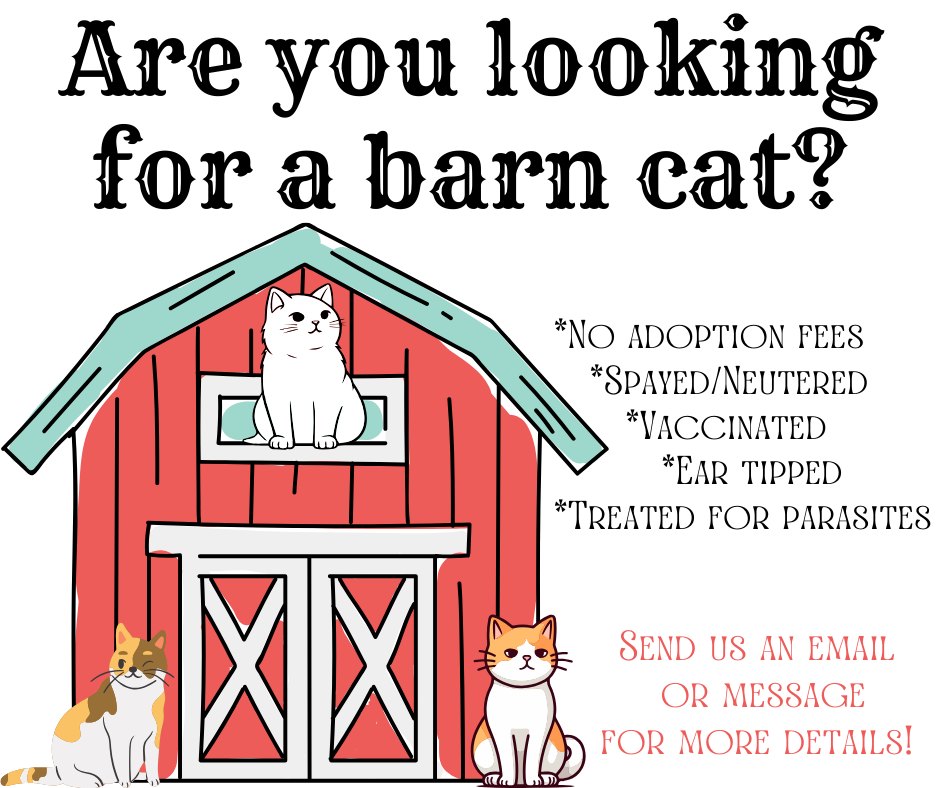
It depends. Usually, you will be placed on our “Barn Cats” waiting list. This is because we don't typically house cats that are barn cat material. In some circumstances, we may have cats that we try to socialize, but do not make enough progress to be happy as indoor companions. In most cases we will reach out to barn cat applicants when we have a cat available for a barn home.
These hard working, pest reducing cats naturally help control the rodent population while they enjoy the freedom of outdoor sheltered life with as little or as much human contact as they desire. They love their job and they'll learn to love you, but on their own terms.
Barn cats are also the safest way to control the rodent population in your barn. There are no poisons for children and pets to get into. When you poison a rodent, you do not know WHERE it is going to die.
- A warm, secure, dry barn or building in which the cats can live out their lives.
- The commitment and ability to keep the cats confined to an escape proof room (tack room) or a large wire dog crate for 4-5 weeks to acclimate them to their new environment before release.
- A clean litter box that is scooped and/or cleaned daily while confined.
- A constant supply of dry food and fresh water. While confined and for a short while after release, you will provide a small amount of canned food daily. What cat can resist that?
- Monitoring and providing for the safety and well-being of the cats as their caretakers.
- Spending time daily making verbal contact with the cats so that they become familiar with you.
- All cats will be spayed or neutered prior to placement.
- All cats will be vaccinated against FVRCP & Rabies
- All cats will be ear-tipped.
- Detailed instructions on safely confining, releasing, and maintaining the barn cats.
Although Finn's Furever Feline Rescue does not charge an adoption fee for barn cats, we are a 501(c)(3) charitable organization that relies on your monetary contributions to operate. Any contribution you would like to make is much appreciated! All donations help pay for spay/neuter surgery, vaccinations, and other medical treatment if necessary.
Finn's Furever Feline Rescue recommends that at least two cats always be moved together. They should be cats who have formed a bond or at least get along with each other. The move will be less traumatic and adjustment to their new home easier if they have the security of one or more trusted companions.
Cats need to be confined initially in their new home for at least 4-5 weeks so they can familiarize themselves with their new environment, so that they will remain on the premises. Even though there are instances of cats remaining when they have escaped upon arrival, this is rare and most cats will take off, never to be seen again. Other than being dangerous for the cat, this can be traumatic for the caregiver who has usually put a lot of time, energy, money, and care into the cat.
Some people see confinement as cruel, but a short confinement period is a very necessary part of the relocation project. Not confining the cats and having them run off could mean a far worse fate for the cats. You should know that during the first day or two, the cats may struggle to find a way out. Most cats settle down in the crate after a day or two when they realize that no harm will come to them.
The adopter will need an escape proof room (ie: tack room or office) An extra-large dog crate (48inch) works great as well allowing the cat to see his/surroundings. FFFR will loan a crate to you if you do not have your own. These items will be returned to FFFR at the end of the 4-5 week confinement period. The adopter must provide the cats with: a litter box, which needs to be scooped or cleaned daily; dry food and fresh water at all times; and a portion of canned food every day. It is recommended that a portion of the cage/crate be covered with a sheet. This will allow the cats to feel more protected and hidden.
In winter, straw should be used as well as an outdoor heating pad should be used. Additionally, the caregiver may wish to place bales of straw around the enclosure to help maintain warmth for the confined cats. During spells of freezing weather, the caretaker must be sure to give fresh water throughout the day as the cat's water becomes frozen. In summer, proper ventilation is vital to prevent overheating. Cats can and do become overheated.
If your cats are in an enclosure (not confined in crates)
Choose a day that you are home all day. Release early in the morning when the sun is up. All you'll do is open the enclosure door and allow the cats to come out on their own. You'll leave their enclosure set up exactly same way indefinitely (if this is not possible, leave their setup untouched for 1-2 weeks minimum); it's their safe zone, and they will continue to come back to that. Continue to feed in the enclosure and then feed in the new area (if applicable). When you release the cats, make sure you continue to give them wet food morning and night. Do not release when it's raining or the day before or after it's rained.
If your crates are set up in a barn or other structure that is enclosed
It's best to close all doors and windows in the barn, open the crate door in the evening, then leave. The cats will want to explore their new surroundings all night, as they are nocturnal. By morning, they will have found good hiding places, although they may prefer the security of their crate. You can ease the transition by continuing to place their food and water in the crate for a few days with the door open. You will need to continue providing daily food and water. After 1-2 days, or when you feel the cats have gotten used to their enclosure/barn with the door closed, you will open the barn/enclosure door early in the morning the following day, and allow the cats to walk out on their own.
DO NOT RELEASE IF IT IS RAINING or the POTENTIAL FOR RAIN
Cats find their home by scent and rain will wash it away. Waiting one more day will not hurt. Leave the crates up for an additional five days, so the cats can get back in if they want. After the release, we hope they think of that barn as home and decide to stay.
They will like the regular food and water you provide (cats cannot live on mousing alone). They may even begin to show affection. The key to success will be your patience while they adapt to the sights, sounds and smells of their new surroundings. Continue to speak softly to them, try hand feeding treats and leave a radio on to help them get used to human talking and singing. Cats are territorial creatures; they will usually maintain a home base once their scent has been established, a continuous food source is provided, and they feel safe.
